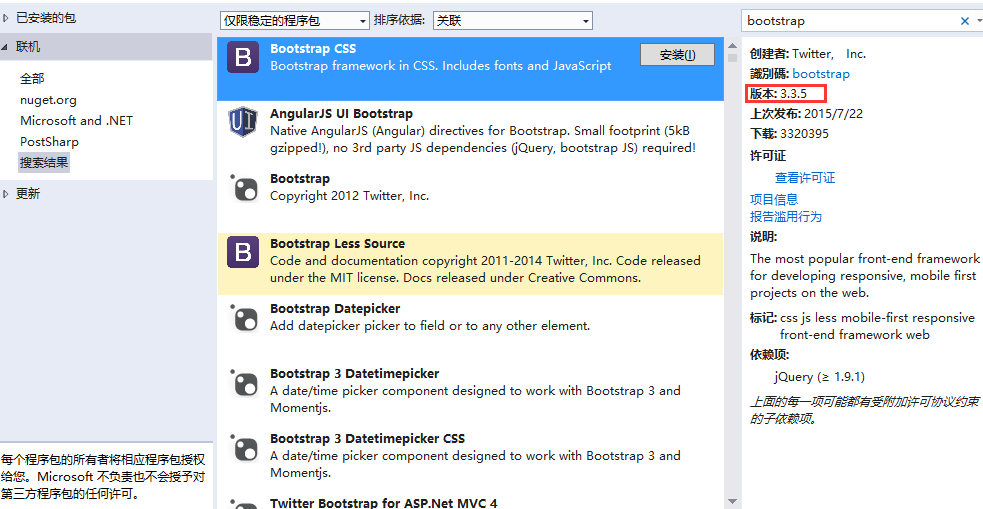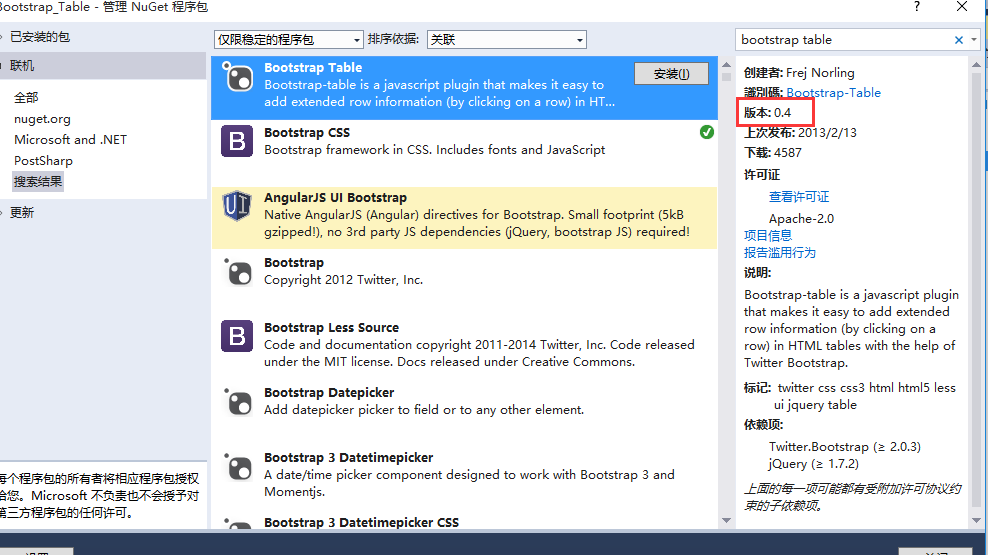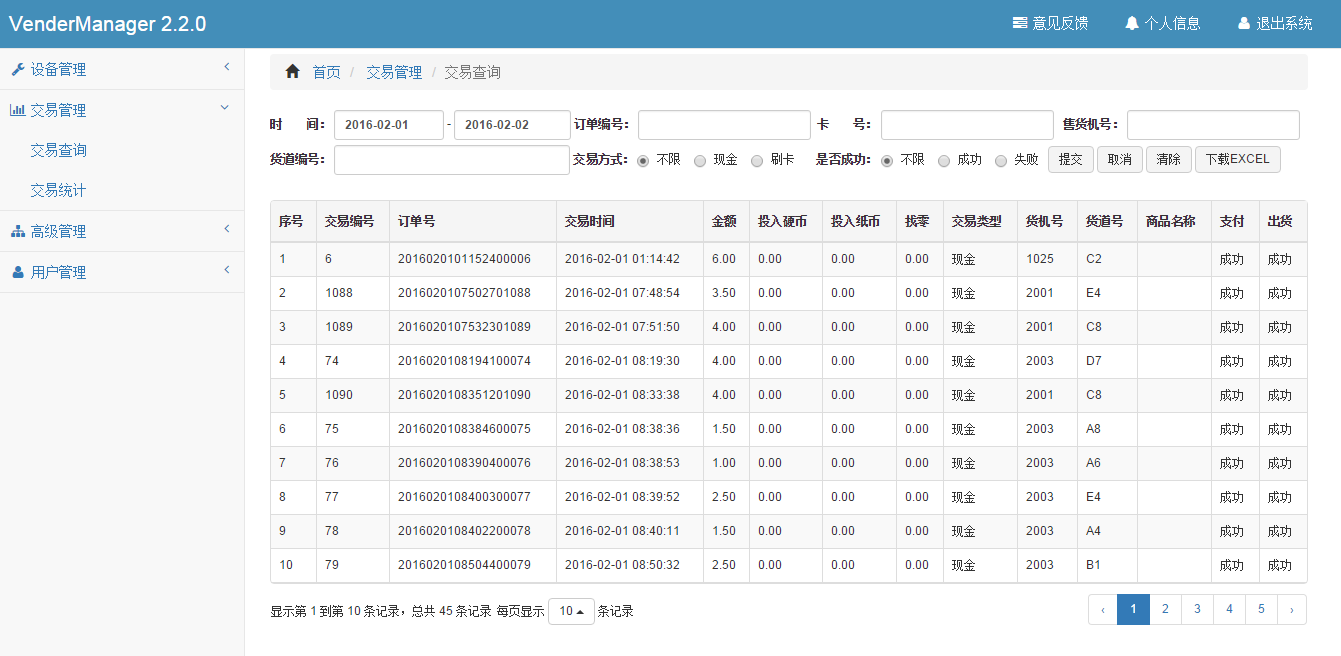 Web Front-end
Web Front-end
 JS Tutorial
JS Tutorial
 Detailed explanation of JS table component artifact bootstrap table (enhanced version)
Detailed explanation of JS table component artifact bootstrap table (enhanced version)
Detailed explanation of JS table component artifact bootstrap table (enhanced version)
Jan 04, 2017 am 11:52 AM1. Introduction of Bootstrap Table
Regarding the introduction of Bootstrap Table, there are generally two methods:
1. Directly download the source code and add it to the project.
Since Bootstrap Table is a component of Bootstrap, it depends on Bootstrap. We first need to add a reference to Bootstrap.
2. Use our magical Nuget
Open Nuget and search for these two packages

Bootstrap is already the latest 3.3.5, we Just install it directly.

The version of Bootstrap Table is actually 0.4, which is too cheating. Therefore, the blogger suggests that the Bootstrap Table package should be downloaded directly from the source code. The latest version of Bootstrap Table seems to be 1.9.0.
Introduction to the background of this article:
Recently, customers have put forward demands and want to optimize the original management system so that it can be displayed well through mobile phones. Two solutions come to mind:
a Plan: Keep the original page and design a new page suitable for mobile phones. When accessed by mobile phone, enter m.zhy.com (mobile page). When accessed by PC device, enter www.zhy.com (pc page). )
b plan: Use bootstrap framework to replace the original page and automatically adapt to mobile phones, tablets, and PC devices
Using plan a, you need to design an interface and rewrite the appropriate page Interface, considering time and cost issues, the project adopted plan b
2. Effect display

2. Brief introduction to BootStrap table
bootStrap table is a lightweight table plug-in that uses AJAX to obtain data in JSON format. Its paging and data filling are very convenient and supports internationalization.
3. How to use
1. Introducing js and css
<!--css樣式--> <link href="css/bootstrap/bootstrap.min.css" rel="stylesheet"> <link href="css/bootstrap/bootstrap-table.css" rel="stylesheet"> <!--js--> <script src="js/bootstrap/jquery-1.12.0.min.js" type="text/javascript"></script> <script src="js/bootstrap/bootstrap.min.js"></script> <script src="js/bootstrap/bootstrap-table.js"></script> <script src="js/bootstrap/bootstrap-table-zh-CN.js"></script>
2. Table data filling
bootStrap table has two ways to obtain data. One is to specify the data source through the data-url attribute of the table; the other is Specify the url to obtain the data when initializing the table through JavaScript
<table data-toggle="table"> <thead> ... </thead> </table> ...
$('#table').bootstrapTable({
url: 'data.json'
});The second method is more flexible than the first method when processing complex data. The second method is generally used to fill the table data.
$(function () {
//1.初始化Table
var oTable = new TableInit();
oTable.Init();
//2.初始化Button的點擊事件
/* var oButtonInit = new ButtonInit();
oButtonInit.Init(); */
});
var TableInit = function () {
var oTableInit = new Object();
//初始化Table
oTableInit.Init = function () {
$('#tradeList').bootstrapTable({
url: '/VenderManager/TradeList', //請求后臺的URL(*)
method: 'post', //請求方式(*)
toolbar: '#toolbar', //工具按鈕用哪個容器
striped: true, //是否顯示行間隔色
cache: false, //是否使用緩存,默認(rèn)為true,所以一般情況下需要設(shè)置一下這個屬性(*)
pagination: true, //是否顯示分頁(*)
sortable: false, //是否啟用排序
sortOrder: "asc", //排序方式
queryParams: oTableInit.queryParams,//傳遞參數(shù)(*)
sidePagination: "server", //分頁方式:client客戶端分頁,server服務(wù)端分頁(*)
pageNumber:1, //初始化加載第一頁,默認(rèn)第一頁
pageSize: 50, //每頁的記錄行數(shù)(*)
pageList: [10, 25, 50, 100], //可供選擇的每頁的行數(shù)(*)
strictSearch: true,
clickToSelect: true, //是否啟用點擊選中行
height: 460, //行高,如果沒有設(shè)置height屬性,表格自動根據(jù)記錄條數(shù)覺得表格高度
uniqueId: "id", //每一行的唯一標(biāo)識,一般為主鍵列
cardView: false, //是否顯示詳細(xì)視圖
detailView: false, //是否顯示父子表
columns: [{
field: 'id',
title: '序號'
}, {
field: 'liushuiid',
title: '交易編號'
}, {
field: 'orderid',
title: '訂單號'
}, {
field: 'receivetime',
title: '交易時間'
}, {
field: 'price',
title: '金額'
}, {
field: 'coin_credit',
title: '投入硬幣'
}, {
field: 'bill_credit',
title: '投入紙幣'
}, {
field: 'changes',
title: '找零'
}, {
field: 'tradetype',
title: '交易類型'
},{
field: 'goodmachineid',
title: '貨機(jī)號'
},{
field: 'inneridname',
title: '貨道號'
},{
field: 'goodsName',
title: '商品名稱'
}, {
field: 'changestatus',
title: '支付'
},{
field: 'sendstatus',
title: '出貨'
},]
});
};
//得到查詢的參數(shù)
oTableInit.queryParams = function (params) {
var temp = { //這里的鍵的名字和控制器的變量名必須一直,這邊改動,控制器也需要改成一樣的
limit: params.limit, //頁面大小
offset: params.offset, //頁碼
sdate: $("#stratTime").val(),
edate: $("#endTime").val(),
sellerid: $("#sellerid").val(),
orderid: $("#orderid").val(),
CardNumber: $("#CardNumber").val(),
maxrows: params.limit,
pageindex:params.pageNumber,
portid: $("#portid").val(),
CardNumber: $("#CardNumber").val(),
tradetype:$('input:radio[name="tradetype"]:checked').val(),
success:$('input:radio[name="success"]:checked').val(),
};
return temp;
};
return oTableInit;
};The field field must correspond to the field returned by the server to display the data.
3. Obtaining data from the background
a. Obtaining data from servlet
BufferedReader bufr = new BufferedReader(
new InputStreamReader(request.getInputStream(),"UTF-8"));
StringBuilder sBuilder = new StringBuilder("");
String temp = "";
while((temp = bufr.readLine()) != null){
sBuilder.append(temp);
}
bufr.close();
String json = sBuilder.toString();
JSONObject json1 = JSONObject.fromObject(json);
String sdate= json1.getString("sdate");//通過此方法獲取前端數(shù)據(jù)
...b. Obtaining data through the corresponding method in springMvc Controller
public JsonResult GetDepartment(int limit, int offset, string orderId, string SellerId,PortId,CardNumber,Success,maxrows,tradetype)
{
...
}4. Paging ( The most encountered problems)
When using paging, the data returned by the server must include rows and total. The code is as follows:
...<br>gblst = SqlADO.getTradeList(sql,pageindex,maxrows);
JSONArray jsonData=new JSONArray();
JSONObject jo=null;
for (int i=0,len=gblst.size();i<len;i++)
{
TradeBean tb = gblst.get(i);
if(tb==null)
{
continue;
}
jo=new JSONObject();
jo.put("id", i+1);
jo.put("liushuiid", tb.getLiushuiid());
jo.put("price", String.format("%1.2f",tb.getPrice()/100.0));
jo.put("mobilephone", tb.getMobilephone());
jo.put("receivetime", ToolBox.getYMDHMS(tb.getReceivetime()));
jo.put("tradetype", clsConst.TRADE_TYPE_DES[tb.getTradetype()]);
jo.put("changestatus", (tb.getChangestatus()!=0)?"成功":"失敗");
jo.put("sendstatus", (tb.getSendstatus()!=0)?"成功":"失敗");
jo.put("bill_credit", String.format("%1.2f",tb.getBill_credit()/100.0));
jo.put("changes",String.format("%1.2f",tb.getChanges()/100.0));
jo.put("goodroadid", tb.getGoodroadid());
jo.put("SmsContent", tb.getSmsContent());
jo.put("orderid", tb.getOrderid());
jo.put("goodsName", tb.getGoodsName());
jo.put("inneridname", tb.getInneridname());
jo.put("xmlstr", tb.getXmlstr());
jsonData.add(jo);
}
int TotalCount=SqlADO.getTradeRowsCount(sql);
JSONObject jsonObject=new JSONObject();
jsonObject.put("rows", jsonData);//JSONArray
jsonObject.put("total",TotalCount);//總記錄數(shù)
out.print(jsonObject.toString()); <br>...5. Introduction to the content of the paging interface
Front-end acquisition Paging data, the code is as follows:
...<br>oTableInit.queryParams = function (params) {
var temp = { //這里的鍵的名字和控制器的變量名必須一直,這邊改動,控制器也需要改成一樣的
limit: params.limit, //第幾條記錄
offset: params.offset, //顯示一頁多少記錄
sdate: $("#stratTime").val(),
};
return temp;
};<br>...
The backend gets the paging data, the code is as follows:
...<br>int pageindex=0;
int offset = ToolBox.filterInt(json1.getString("offset"));
int limit = ToolBox.filterInt(json1.getString("limit"));
if(offset !=0){
pageindex = offset/limit;
}
pageindex+= 1;//第幾頁<br>...The above is the entire content of this article, I hope it can Help everyone better learn the JS table component artifact bootstrap table.
For more detailed explanations of the JS table component artifact bootstrap table (enhanced version), please pay attention to the PHP Chinese website!

Hot AI Tools

Undress AI Tool
Undress images for free

Undresser.AI Undress
AI-powered app for creating realistic nude photos

AI Clothes Remover
Online AI tool for removing clothes from photos.

Clothoff.io
AI clothes remover

Video Face Swap
Swap faces in any video effortlessly with our completely free AI face swap tool!

Hot Article

Hot Tools

Notepad++7.3.1
Easy-to-use and free code editor

SublimeText3 Chinese version
Chinese version, very easy to use

Zend Studio 13.0.1
Powerful PHP integrated development environment

Dreamweaver CS6
Visual web development tools

SublimeText3 Mac version
God-level code editing software (SublimeText3)

Hot Topics
 JavaScript vs. Java: Which Language Should You Learn?
Jun 10, 2025 am 12:05 AM
JavaScript vs. Java: Which Language Should You Learn?
Jun 10, 2025 am 12:05 AM
JavaScriptisidealforwebdevelopment,whileJavasuitslarge-scaleapplicationsandAndroiddevelopment.1)JavaScriptexcelsincreatinginteractivewebexperiencesandfull-stackdevelopmentwithNode.js.2)Javaisrobustforenterprisesoftwareandbackendsystems,offeringstrong
 Which Comment Symbols to Use in JavaScript: A Clear Explanation
Jun 12, 2025 am 10:27 AM
Which Comment Symbols to Use in JavaScript: A Clear Explanation
Jun 12, 2025 am 10:27 AM
In JavaScript, choosing a single-line comment (//) or a multi-line comment (//) depends on the purpose and project requirements of the comment: 1. Use single-line comments for quick and inline interpretation; 2. Use multi-line comments for detailed documentation; 3. Maintain the consistency of the comment style; 4. Avoid over-annotation; 5. Ensure that the comments are updated synchronously with the code. Choosing the right annotation style can help improve the readability and maintainability of your code.
 The Ultimate Guide to JavaScript Comments: Enhance Code Clarity
Jun 11, 2025 am 12:04 AM
The Ultimate Guide to JavaScript Comments: Enhance Code Clarity
Jun 11, 2025 am 12:04 AM
Yes,JavaScriptcommentsarenecessaryandshouldbeusedeffectively.1)Theyguidedevelopersthroughcodelogicandintent,2)arevitalincomplexprojects,and3)shouldenhanceclaritywithoutclutteringthecode.
 Javascript Comments: short explanation
Jun 19, 2025 am 12:40 AM
Javascript Comments: short explanation
Jun 19, 2025 am 12:40 AM
JavaScriptcommentsareessentialformaintaining,reading,andguidingcodeexecution.1)Single-linecommentsareusedforquickexplanations.2)Multi-linecommentsexplaincomplexlogicorprovidedetaileddocumentation.3)Inlinecommentsclarifyspecificpartsofcode.Bestpractic
 Java vs. JavaScript: Clearing Up the Confusion
Jun 20, 2025 am 12:27 AM
Java vs. JavaScript: Clearing Up the Confusion
Jun 20, 2025 am 12:27 AM
Java and JavaScript are different programming languages, each suitable for different application scenarios. Java is used for large enterprise and mobile application development, while JavaScript is mainly used for web page development.
 Mastering JavaScript Comments: A Comprehensive Guide
Jun 14, 2025 am 12:11 AM
Mastering JavaScript Comments: A Comprehensive Guide
Jun 14, 2025 am 12:11 AM
CommentsarecrucialinJavaScriptformaintainingclarityandfosteringcollaboration.1)Theyhelpindebugging,onboarding,andunderstandingcodeevolution.2)Usesingle-linecommentsforquickexplanationsandmulti-linecommentsfordetaileddescriptions.3)Bestpracticesinclud
 JavaScript Data Types: A Deep Dive
Jun 13, 2025 am 12:10 AM
JavaScript Data Types: A Deep Dive
Jun 13, 2025 am 12:10 AM
JavaScripthasseveralprimitivedatatypes:Number,String,Boolean,Undefined,Null,Symbol,andBigInt,andnon-primitivetypeslikeObjectandArray.Understandingtheseiscrucialforwritingefficient,bug-freecode:1)Numberusesa64-bitformat,leadingtofloating-pointissuesli
 JavaScript: Exploring Data Types for Efficient Coding
Jun 20, 2025 am 12:46 AM
JavaScript: Exploring Data Types for Efficient Coding
Jun 20, 2025 am 12:46 AM
JavaScripthassevenfundamentaldatatypes:number,string,boolean,undefined,null,object,andsymbol.1)Numbersuseadouble-precisionformat,usefulforwidevaluerangesbutbecautiouswithfloating-pointarithmetic.2)Stringsareimmutable,useefficientconcatenationmethodsf





